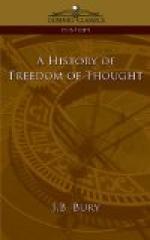Religious liberty, however, among other good things, did emerge from the Revolution, at first in the form of Separation, and then under the Concordat. The Concordat lasted for more than a century, under monarchies and republics, till it was abolished in December, 1905, when the system of Separation was introduced again.
In the German States the history of religious liberty differs in many ways, but it resembles the development in France in so far as toleration in a limited form was at first brought about by war. The Thirty Years’ War, which divided Germany in the first half
[118] of the seventeenth century, and in which, as in the English Civil War, religion and politics were mixed, was terminated by the Peace of Westphalia (1648). By this act, three religions, the Catholic, the Lutheran, and the Reformed [4] were legally recognized by the Holy Roman Empire, and placed on an equality; all other religious were excluded. But it was left to each of the German States, of which the Empire consisted, to tolerate or not any religion it pleased. That is, every prince could impose on his subjects whichever of the three religions he chose, and refuse to tolerate the others in his territory. But he might also admit one or both of the others, and he might allow the followers of other creeds to reside in his dominion, and practise their religion within the precincts of their own houses. Thus toleration varied, from State to State, according to the policy of each particular prince.
As elsewhere, so in Germany, considerations of political expediency promoted the growth of toleration, especially in Prussia; and as elsewhere, theoretical advocates exercised great influence on public opinion. But the case for toleration was based by its German defenders chiefly on legal, not, as in
[119] England and France, on moral and intellectual grounds. They regarded it as a question of law, and discussed it from the point of view of the legal relations between State and Church. It had been considered long ago from this standpoint by an original Italian thinker, Marsilius of Padua (thirteenth century), who had maintained that the Church had no power to employ physical coercion, and that if the lay authority punished heretics, the punishment was inflicted for the violation not of divine ordinances but of the law of the State, which excluded heretics from its territory.
Christian Thomasius may be taken as a leading exponent of the theory that religious liberty logically follows from a right conception of law. He laid down in a series of pamphlets (1693-1697) that the prince, who alone has the power of coercion, has no right to interfere in spiritual matters, while the clergy step beyond their province if they interfere in secular matters or defend their faith by any other means than teaching. But the secular power has no legal right to coerce heretics unless heresy is a crime. And heresy is not a crime, but an error; for it is not a matter of will. Thomasius, moreover, urges the view that the public welfare has nothing to gain from unity of faith, that it makes no




